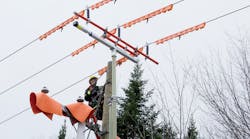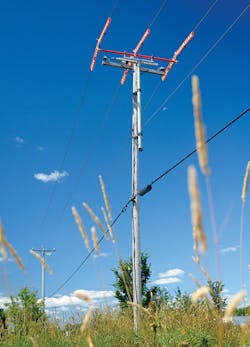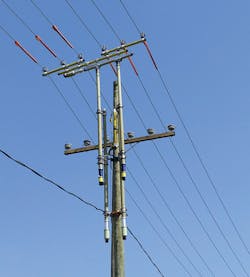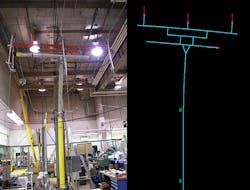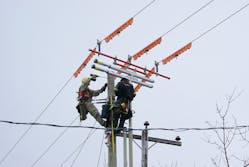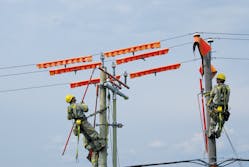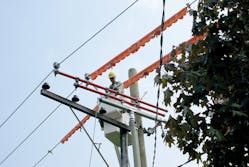Hydro-Québec strives to minimize service interruptions by performing as much work as possible on live overhead distribution lines. However, live-line work is complex and time consuming. For example, in accessible areas, transferring conductors from a live overhead line to a new pole can take 70% more time on average than from a deenergized line. Hence, in inaccessible areas, conductors must be handled remotely using live-line hot sticks without mechanical assistance. This type of work is both physically demanding and takes 90% longer to complete.
However, motorized equipment can facilitate and accelerate the work of crews performing routine maintenance on overhead lines, including replacing crossarms, insulators or other hardware — especially when the work involves replacing wood poles.
Hydro-Québec’s overhead distribution system includes some 2.5 million poles, many of which are inaccessible by a bucket truck. A lot of the poles are nearing the end of their useful lives and will have to be replaced in the next 10 to 20 years. Because replacing inaccessible poles — especially those installed in back lots — is difficult and costly, use of a motorized manipulator would make the operation much more efficient. For this reason, based on a mandate from the utility’s distribution division, the Hydro-Québec Research Institute (IREQ) developed a motorized remote-control manipulator that could lift and move overhead line conductors on distribution networks operating in the voltage range of 25 kV to 49 kV.
Manipulator Design
Overhead distribution lines consist of a limited number of structural components (for example, phase conductors, pilot wires, stay and guy wires, poles, crossarms and insulators) and are constructed in a wide variety of configurations, depending on the design of the overhead line and equipment installed. In addition to versatility, the manipulator needed to have a modular design with two functional parts:
- A motorized head for grabbing conductors and moving them horizontally.
- A motorized support piece for vertical movement of the head.
The manipulator head includes basic components such as a motorized horizontal rail as well as an insulating crossarm with conductor holders and insulators attached to the upper end of a vertical support. Two types of vertical supports are available for the head: a telescopic mast attached to the pole by two brackets and a self-supporting telescopic column mounted on a motorized trolley. Use of the telescopic column offered a considerable advantage because it eliminates the need to mount the manipulator on the pole. The telescopic column also makes the operation easier for overhead line workers and accelerates replacement operations. With these basic components, various manipulator configurations can be created based on specific needs identified in the field.
In moving the manipulator head and vertical support by remote control, the conductors first are grabbed and placed in the conductor holders and then lifted clear of the safe liveline work area. The vertical and horizontal movements of the manipulator are controlled by independent modules. Each module includes an electric motor powered by a removable, rechargeable battery and a remote-control unit with a radio-frequency receiver.
Complementary accessories, such as a gin pole and battery-operated hoist, also were developed for easier installation of the manipulator on a pole. They support lifting the manipulator, partly preassembled on the ground, and securing it at the required pole height.
Choice of Components
The choice of materials and sizing of components was critically important to ensuring adequate manipulator strength and stiffness, a key consideration for live-line work safety. Certain components — such as insulators, insulating crossarms and brackets for fastening the masts to the pole — are standard Hydro-Québec equipment. All other structural components were designed specifically for the manipulator.
Careful attention was given to the selection of tube material for the telescopic mast, and bending failure tests were conducted on composite tubes supplied from several manufacturers. These tests showed only one type of tube met the requirements for the manipulator, namely, polygon tubes made with glass fibers inclined 30 degrees to the longitudinal axis.
Hot sticks bearing the manipulator insulators also underwent bending failure tests. The hot stick tubes, made of fiberglass-reinforced composite with a filament winding, are filled with foam for added strength and stiffness. The tests demonstrated their satisfactory strength and highly ductile failure mode, favoring their safe use for the manipulator.
The tests also evaluated two mechanical properties related to structural component strength and stiffness: ultimate tensile strength and Young’s modulus in terms of longitudinal bending. These two properties were necessary for finite element modeling of the whole manipulator structure at the design stage, to ensure the manipulator was sufficiently strong and stiff to withstand projected loads during its use on the distribution network.
Laboratory Testing
Qualification tests were conducted in the laboratory and on a test overhead line to validate proper operation of the manipulator prototype, developed at IREQ and fabricated by MOVEX Innovation Inc.
Two poles installed side by side on bases solidly anchored to the laboratory floor replicated typical on-site conditions where pole replacement was required. The vertical and side forces (calculated estimates) were exerted on the manipulator, attached to the replacement pole. This simulation was achieved using a system of weights and elastics. The vertical force exerted by a conductor is its dead weight and the lifting force. The side force, representing wind pressure and possible changes in line direction, is generated by weights transmitted to the manipulator head by a rope and pulley setup. Longitudinal forces are negligible given the conductors can slide in the roller conductor holders, specially designed for that purpose.
Overall, the tests demonstrated the manipulator worked well under the various onsite conditions simulated in the laboratory. No problems were encountered in performing the necessary operations when transferring conductors. The mechanical strength was adequate, and the manipulator deformation was acceptable.
For example, vertical forces of 1000 N (225 lb) — representing the conductor dead weight and vertical component of stress in the conductor — were applied to each of the three insulators. In addition, a side strain of 1400 N (315 lb) — representing wind pressure of 56 mph (90 kmph) — was applied to the manipulator head. Under that strain, there was a fairly strong deformation of the deployed upper tube of the telescopic mast. However, no sign of mechanical failure of the components was observed.
Finally, the manipulator was subjected to 1500 operating cycles, representative of its use on the overhead line distribution network, to evaluate its long-term durability and proper operation. The tests confirmed satisfactory manipulator performance throughout the 500 or so test hours, and there were no signs the manipulator suffered premature wear.
Overhead Line Tests
Qualification testing for the manipulator also was conducted on an overhead line configured for the specific test requirements. Built on the IREQ site, the four-span overhead line, measuring about 130 ft (40 m), was supported by 40-ft (12-m) wood poles. A replacement pole was installed next to each of these poles, replicating the various conditions encountered when replacing poles on-site.
Various manipulator configurations were tested, including the following two configurations:
- The manipulator was used to transfer conductors from a three-phase line to a pole more than 5 ft (1.5 m) taller. For this situation, two series-mounted telescopic masts were required for safe work-area clearance.
- The manipulator was used to lift six conductors of a double-circuit line. The manipulator head, consisting of a horizontal rail and three insulating crossarms, was supported by four telescopic masts.
A system of sensors was used to monitor the forces and deformations exerted on the manipulator when conductors were being transferred from one pole to another. The data recorded provided validation of the finite element calculation models.
Network Testing
Based on the positive and conclusive results of the qualification testing in the laboratory and on the test overhead line, use of the manipulator then was subjected to rigorous testing under actual network conditions. This included various tests conducted on energized overhead line conditions at locations inaccessible by a bucket truck. These selected on-site tests included the following situations:
- Test 1 involved the transfer of three-phase conductors to a pole 5 ft (1.5 m) taller that was installed between two phases.
- Test 2 proved especially complicated because the new pole was installed outside the phase conductors of the existing pole, which was very tilted. Two horizontal rails had to be used in this situation.
- Test 3 involved the transfer of three-phase conductors to a pole installed at a distance from the existing pole. This operation took five hours, and no customers (including a hospital) were subjected to an interrupted supply.
- Test 4 involved the transfer of a cantilevered line that required the use of an intermediate hot stick with a longer head for the operation.
As a result of such thorough testing of the manipulator in laboratory and on-site conditions, it was concluded the use of a motorized manipulator would be efficient and cost-effective in actual conditions on Hydro-Québec’s overhead distribution network. The overall cost savings associated with the use of the manipulator at the eight sites was assessed at CAN$563,000, primarily attributable to the reduction in execution times and uninterrupted customer service. Furthermore, the manipulator met the needs of linemen, who provided positive comments and gave the manipulator a rating of 8.85 out of 10.
A Favorable Future
Given the favorable experience feedback regarding the use of the manipulator on the distribution network, Hydro-Québec decided to industrialize this technology and approved the use of the manipulator in its overhead line distribution network maintenance standards. To date, the utility has procured 30 manipulators, manufactured under a Hydro-Québec license by MOVEX Innovation, and has begun training its linemen.
In response to the interest received in this development, commercialization of the technology is being prepared by the utility’s technology development department. The potential economic impact for Hydro-Québec has been estimated at CAN$135 million over a 15-year period.
Acknowledgment
The authors wish to acknowledge the technical contribution provided by Michel Belley of Hydro-Québec IREQ in the development of the motorized manipulator.
André Lessard ([email protected]) graduated from the Teccart Institute, École de Technologie Supérieure in Montréal, Canada. In 1984, he joined Hydro-Québec, where he has worked in several fields of activity. He started as a lineman in distribution and then obtained the position of expert technologist at Hydro-Québec Research Institute IREQ. He concentrated his expertise on transmission and distribution as well as in substations and power stations. For the last 15 years, he has been project manager of innovation distribution networks and holds three patents for inventions related to the modular and versatile remote manipulator.
Janislaw Tarnowski ([email protected]) graduated from the faculty of mechanical engineering at the Technical University of Gdansk, Poland, having earned his Ph.D. in 1977. Until 1990, he occupied full-time academic positions in Poland and Algeria. In 1991, Tarnowski joined Hydro-Québec as a senior scientist at its Research Institute (IREQ). His areas of expertise are mechanical engineering aspects related to overhead lines and underground cables. Over the last 27 years, he has worked on a variety of projects, mostly as a project leader.
For more information:
Hydro-Québec | www.hydroquebec.com
MOVEX Innovation | www.movexinnovation.com
